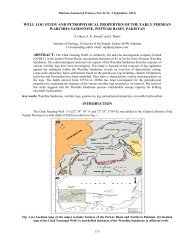GENETICALLY MODIFIED ORGANISMS (GMOs ... - Paas.com.pk
GENETICALLY MODIFIED ORGANISMS (GMOs ... - Paas.com.pk
GENETICALLY MODIFIED ORGANISMS (GMOs ... - Paas.com.pk
Create successful ePaper yourself
Turn your PDF publications into a flip-book with our unique Google optimized e-Paper software.
Pakistan Journal of Science (Vol. 64 No. 2 June, 2012)<br />
transferred to other bacteria in the environment and<br />
throughout the human body. (Benbrook,2004).<br />
Birth Defects and Shorter Life Spans: As we ingest<br />
transgenic human/ animal products there is no real telling<br />
of the impact on human evolution. It is reported rBGh in<br />
cows causes a rapid increase in birth defects and shorter<br />
life spans. (Mead et al.,1999).<br />
Lowered Nutrition: A study in the Journal of Medicinal<br />
Food conducted by Lappe and Bailey (1998) showed that<br />
certain GM foods have lower levels of vital nutrients –<br />
especially phytoestrogen <strong>com</strong>pounds thought to protect<br />
the body from heart disease and cancer. Other studies<br />
show that if GM foods are fed to animals, GM material<br />
can appear in the resulting products (Sharma, 2006;<br />
Agodi, 2006; Ran et al., 2009) and affect the animals’<br />
health (Tudisco et al., 2010; Heinemann, 2009).<br />
Radical Change in Diet: Humanity has evolved for<br />
thousands of years by adapting gradually to its natural<br />
environment - including nature's foods. Within past few<br />
years a fundamental transformation of the human diet has<br />
occurred. In short, the human diet, from almost every<br />
front, is being radically changed - with little or no<br />
knowledge of the long-term health or environmental<br />
effects.( Jeffery, 2007).<br />
Poisonous to Mammals: In a study with GM potatoes,<br />
spliced with DNA from the snowdrop plant and a viral<br />
promoter (CaMV), the resulting plant was poisonous to<br />
mammals (rats) – damaging vital organs, the stomach<br />
lining and immune system (Kuiper et al., 2001). CaMV is<br />
a pararetrovirus. It can reactivate dormant viruses or<br />
create new viruses - as some presume have occurred with<br />
the AIDES epidemic. CaMV is promiscuous, therefore<br />
biologist Ho (1998) concluded that "all transgenic crops<br />
containing CaMV 35S or similar promoters which are<br />
re<strong>com</strong>binogenic should be immediately withdrawn from<br />
<strong>com</strong>mercial production or open field trials. All products<br />
derived from such crops containing transgenic DNA<br />
should also be immediately withdrawn from sale and<br />
from use for human consumption or animal feed."<br />
ENVIRONMENTAL HAZARDS<br />
Toxicity to Soil: The industry’s marketing pitch to the<br />
public is that bioengineered seeds and plants will help the<br />
environment by reducing toxic herbicide/pesticide use<br />
(Benbrook, 2009). Isolated examples are given, but the<br />
overall reality is exactly opposite. According to an article<br />
by Goldburg (1992) scientists predict that herbicide use<br />
will triple as a result of GM products.<br />
Soil sterility and Pollution: In Oregon, scientists found<br />
GM bacterium (klebsiella planticola) meant to break<br />
down wood chips, corn stalks and lumber wastes to<br />
produce ethanol - with the post-process waste to be used<br />
as <strong>com</strong>post - rendered the soil sterile. It killed essential<br />
soil nutrients, robbing the soil of nitrogen and killed<br />
nitrogen capturing fungi. Professor Guenther Stotzky of<br />
New York University conducted research showing the<br />
toxins that were lethal to Monarch butterfly (a beneficial<br />
insect) are also released by the roots to produce soil<br />
pollution (Nathan, 2009). The pollution was found to last<br />
up to 8 months in soil with depressed microbial activity<br />
(Conner et al., 2003).<br />
Extinction of Seed Varieties: A few years ago Time<br />
magazine referred to the massive trend by large<br />
corporations to buy up small seed <strong>com</strong>panies, destroying<br />
any <strong>com</strong>peting stock, and replacing it with their patented<br />
or controlled brands as "the Death of Birth." Monsanto<br />
additionally has had farmers sign contracts not to save<br />
their seeds - forfeiting what has long been a farmer's<br />
birthright to remain guardians of the blueprints of<br />
successive life.( Taylor and Tick, 2003)<br />
Superweeds: It has been shown that genetically modified<br />
Bt endotoxin remains in the soil at least 18 months<br />
(Lappe and Bailey, 1998) and can be transported to wild<br />
plants creating superweeds - resistant to butterfly, moth,<br />
and beetle pests – potentially disturbing the balance of<br />
nature. Another study showed 20 times more genetic<br />
leakage with GM plants – or a dramatic increase in the<br />
flow of genes to outside species.<br />
Destruction of Forest Life: Monsanto has developed<br />
plans with the New Zealand Forest Research Agency to<br />
create still more lethal tree plantations. These super<br />
deadly trees are non-flowering, herbicide-resistant and<br />
with leave exuding toxic chemicals to kill caterpillars and<br />
other surrounding insects – destroying the ecology of<br />
forest life. This kind of development has been called<br />
"death-engineering" rather than "life-" or "bioengineering."<br />
More ominously pollen from such trees,<br />
because of their height, has traveled as much as 400 miles<br />
or 600 kilometers - roughly 1/5 of the distance across the<br />
United States.(Losey et al.,1999)<br />
Superpests: Lab tests indicate that <strong>com</strong>mon plant pests<br />
such as cotton boll worms will evolve into Superpests<br />
immune from the BT sprays used by organic farmers<br />
(Bates et al., 2005). The recent epidemic in North<br />
Carolina and Georgia seems linked to bioengineered<br />
plants that the bugs love. Now seed <strong>com</strong>panies like<br />
Monsanto, on their Farm source website, is<br />
re<strong>com</strong>mending spraying stink bug affected areas with<br />
methyl parathion, one of the deadliest chemicals.(<br />
Pollack, 2003)<br />
Genetic Uncertainties<br />
Genetic Pollution: Carrying GM pollen by wind, rain,<br />
birds, bees, insects, fungus, bacteria – the entire chain of<br />
life be<strong>com</strong>es involved. Once released, unlike chemical<br />
pollution, there is no cleanup or recall possible. Pollen<br />
87















